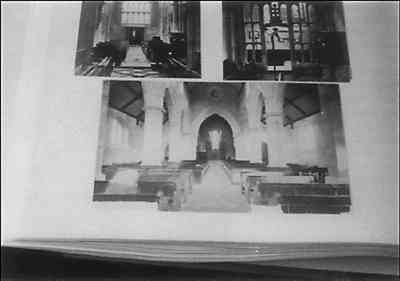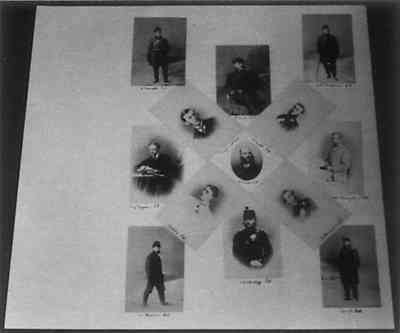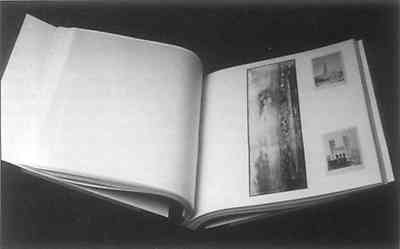THE CONSERVATION OF A PHOTOGRAPH ALBUM AT THE NATIONAL ARCHIVES OF CANADAGREGORY HILL
5 TREATMENTThe author carried out the work in the Picture Conservation Division of the National Archives of Canada. Binders in the Records Conservation Division were responsible for the binding of the album after treatment. The following is a step-by-step outline of the treatment procedure and the various problems encountered. The treatment was documented in a written report with photographs. 5.1 PHOTOGRAPHIC DOCUMENTATIONEach album page containing photographs was documented with 4 � 5 in Kodak Ektachrome 64 Daylight Type 6117 and 4 � 5 in Kodak Technical Pan Film Type 2415. The transparencies were exceedingly valuable records for keeping the 913 unmounted photographs in order. 5.2 DRY CLEANINGFollowing photodocumentation, all pages, excluding photographic emulsions, were dry cleaned with Scum-X eraser powder and vinyl erasers. Due to the sulphur content of most eraser materials, the pages were then thoroughly brushed to remove the residue 5.3 SEARCH FOR REPLACEMENT PAPERFinding an identical replacement for the original album pages was not considered because of their light weight and poor quality. The criteria for selection of a new paper included a number of factors. The paper must be a pure-fiber, nonbuffered, and lignin-and sulphur-free wove sheet. The surface must be smooth, and the sheet must be of a suitable weight to support the photographs and tolerate wet mounting without serious deformation. The color should be sympathetic to the color of albumen prints. After a lengthy search and continued consultation with the curatorial staff and the binders, a paper manufactured by Barcham Green was selected. Penshurst is 100% rag, handmade, 110 lb weight, cream colored, and hot pressed for a smooth finish. As the paper had to be ordered from England, a paper similar in weight and composition was used for testing mounting methods. Although results using aqueous mounting methods were not entirely satisfactory, the order to England was placed, anticipating a two-month delivery time. In fact, the paper took four months to arrive. 5.4 REMOVAL OF THE PHOTOGRAPHS FROM THE PAGESBefore any photographs were removed from a page, a template recording the position of each photograph on a given page was made on a piece of Mylar, using a grease pencil to outline the photographs and page edges. This preliminary step, recommended by Gary Albright, photograph conservator at the Northeast Document Conservation Center in Andover, Massachusetts, greatly facilitated the repositioning of the photographs onto the new pages. Because of the soluble nature of many of the inscriptions, the primary dismounting procedure consisted of applying a methyl cellulose poultice to the verso of the page in the area of the mounted photograph. Where soluble inks were not a problem, the poultice was applied over the entire verso. After 20–30 minutes, the poultice was removed, and, with the photograph lying face down, the page was gently peeled away. In almost half the cases, an excess of hide glue had been used to mount the photograph. The glue layer softened readily on contact with moisture from the poultice, and the photographs were removed almost effortlessly. Residual adhesive was gently removed with a lightly dampened sponge from both page and photograph, and the pages and photographs were left to dry between blotters under a light weight. The primary advantage of this method of removal was that the albumen prints, which are very sensitive to moisture, were not in direct contact with moisture and consequently remained flat. Where the composition of the adhesives was different, the method of removal of the photographs was changed accordingly. Starch pastes and mixtures of starch and hide glues were more tenacious. A microspatula was used to help pry the photographs from pages where these adhesives were used. Some purified gelatin adhesives and some starch pastes proved to be entirely resistant to the poultice method. If soluble elements were not present, these pages were immersed in a warm water bath (50�C), and the photographs floated off. The same removal method was employed for pages with photographs adhered to both recto and verso, if safe to do so. Approximately 10% of the pages were treated in this manner. A third removal technique was developed for cases in which photographs were adhered to both recto and verso of pages containing soluble inscriptions. A mixture of up to 50% ethanol in water was applied to the face of the photograph with a soft brush. Because of The latter two processes were used infrequently due to the greater tendency of albumen prints to curl following immersion in water. In addition, research has indicated that the characteristic cracks in albumen emulsions tend to open up slightly following aqueous immersion (Swan 1981). After each photograph was removed, its page and position were recorded on the verso with graphite. In spite of the care taken when removing the photographs from the pages, approximately 30% of the pages sustained damage due to their poor physical condition. This damage was deemed acceptable after consultation with curatorial staff, as long as inscriptions remained intact. The removal of 913 photographs took 2 � months. 5.5 UNFORESEEN COMPLICATIONSAs the removal of the photographs progressed, unforeseen problems emerged. Inscriptions were discovered on the verso of approximately one-fourth of the images. These inscriptions were primarily studio stamps, photographers' names, or handwritten notations identifying the sitter. At the request of curatorial staff, all verso inscriptions, with a record of their location, were photographed with 35mm film, both color and black and white. Watermarks were discovered on five albumen prints. Of these, four were identified as BFK Rives and the fifth was illegible. The watermarks were thoroughly photodocumented by transmitted and reflected light before the photographs were mounted onto the new album pages. The most disturbing finding was that many photographs had been badly damaged prior to being mounted in the album. Many were skinned, and on several only the delicate emulsion layer survived. Others had sustained losses in image areas and many appear to have been badly degraded by highly acidic mounts. In two instances, photographs were discovered beneath other mounted works. In one, the uncovered image was identical to the one mounted over it but had been badly damaged in a previous removal attempt. The second photograph uncovered was a duplicate of an image found elsewhere in the album. The uncovered photographs were photodocumented and mounted separately. 5.6 REPAIRSPhotographs that had sustained physical damage, either prior to mounting or as a result of rough handling of the album pages, were repaired using dilute wheat starch paste and strips of thin Japanese tissue. Where little remained of the photographic paper or the support was in several pieces, the photograph was fully lined with Japanese tissue and wheat starch paste. After consultation with curatorial staff, the decision was made not to infill losses, and not to paint losses of image (fig. 5). These procedures were deemed unnecessary, as the documentary value of the object took precedence over aesthetic considerations.
5.7 MOUNTING SYSTEMSSThe curators agreed that the photographs should be solidly mounted onto the new album pages. A solid mounting system would provide greater security and less bulk for the photographs than hinging or photo corners, since the album format was being maintained. A variety of aqueous mounting techniques were tested, including drum mounting (pasting down only the perimeter of the print to the new page), dacron lining, and the use of the paper suction table. Although the dacron lining method provided the best results, it was not used because it required pasting out the verso of each album page. The resulting excess of adhesive would be unacceptable, as the face of each photograph would be in contact with the adhesive layer on the verso of the page preceding it. All aqueous methods caused a slight deformation of the album page that cannot be tolerated by the binding operation. A number of nonaqueous adhesives, namely acrylics and poly(vinyl acetates), were selected for testing based on their chemical stability and long-term flexibility. Solvent activation was preferred to heat as the method of adhesion, as many albumen prints are heat sensitive (Reilly et al. 1982). Rhoplex AC-234, an acrylic emulsion, was selected because of its working properties, and a short term photographic stability test was conducted (ANSI 1984). Albumen print step scales (steps of gradually increasing photographic image density from black to white) of gold-toned and untoned, mounted and unmounted samples were prepared and subjected to a temperature of 60�C with an RH of 80% for a seven-day period. Mounted and unmounted samples were separated in different desiccators to avoid potential contamination. The mounted scales consisted of a mounting paper of the same composition as the new album page, solidly adhered to the albumen step scale with Rhoplex AC-234. According to tricolor densities taken on a Macbeth TR924 densitometer before and after incubation, the mounted and unmounted gold-toned step scales remained unchanged while the mounted and unmounted untoned samples faded and stained equally. Mounting tests were then conducted following the procedure outlined below. The Rhoplex was diluted to approximately 60% with deionized water to minimize the amount of adhesive on the Japanese tissue, thereby limiting the amount of adhesive in contact with the photographs and rendering the procedure more easily reversible. The adhesive was brushed onto both sides of thin Japanese tissue and allowed to air dry. The tissue was solvent activated and adhered to the photograph, trimmed, and activated a second time on the verso and placed on the album page. Despite the overwhelmingly favorable results of this procedure, an interlayer was proposed to isolate the photograph from the Rhoplex tissue. Although the interlayer would add slight bulk to the new album pages, the curatorial staff and the binders approved of the proposal. Consequently, all the photographs were initially lined with a thin Japanese tissue and wheat starch paste. To facilitate this procedure, large sheets of Japanese tissue were dampened and then stretched and taped onto mounting boards and allowed to dry. The lining was pasted out with a dry wheat starch paste, and up to 75 humidified photographs were applied to the tissue at a time. Following tests of various solvents for activating the Rhoplex, acetone was selected because the pages remained flat regardless of the number of mounted prints. Although ethanol also worked well and was preferred for its lower toxicity and slower drying time, its increased hygroscopicity resulted in slight cockling of the album pages. By the time the album paper arrived from England, the mounting technique had been perfected, the Rhoplex tissue prepared, and all the photographs had been lined with the The first step in the mounting of the 913 photographs was to adhere the Rhoplex tissue to the verso of the photographs. A piece of the tissue, large enough to accommodate all the prints from one page, was brushed with acetone. The lined prints were positioned, covered with silicone release paper, and rolled out to ensure adhesion. Excess tissue was trimmed from the edges of each print. Next, the Mylar templates were positioned on the new pages, and a pin tool was used to mark the exact location of each print on the page. The verso of each print was lightly brushed with acetone. The photographs were then positioned on the page, covered with silicone release paper, and again gently rolled to ensure adhesion. After all photographs were adhered to a new album page, the page was placed between clean blotters and very gently pressed until the solvent had completely evaporated. Where photographs had been originally mounted on both sides of the page, they were remounted on separate pages for the new album. The procedure was expedited by the fact that following lining and adhesion of the Rhoplex tissue, the photographs were quite flat. As a result of the lengthy delay of the paper shipment, only three weeks were left for the completion of the project. The mounting task was completed in less than two weeks, allowing ample time for the incorporation of the inscriptions (fig. 6).
5.8 INCORPORATION OF INSCRIPTIONSThe inscriptions, hand written either by Lord Russell or a close associate at the time the album was assembled, in most cases provide the only means of identifying the photographs. Several suggestions for incorporating the inscriptions into the new album were considered:
Procedure 3 was preferred by the curatorial staff as it would allow for the original album pages with inscriptions to be preserved intact while marginally maintaining the “look” of the original album. A paper suitable for photocopying and matching the color of the new album pages was found. Domtar Krypton is 100% cotton, light weight, and smooth enough to produce a clean, sharp photocopy. An electrostatic, dry (carbon) pigment process (two component magnetic brush development) was used, and, for the most part, the results were acceptable. In a few cases the discolored original paper reproduced with a gray tone. The curators did not find these instances objectionable, and the copies of the inscriptions were trimmed and mounted on the new album pages with the Rhoplex tissue system (fig. 6). 5.9 HANDPAINTED DECORATIVE MOTIFSThe original treatment plan for album pages that had been embellished with hand-painted decorative borders consisted of removing the photographs, washing and repairing the original page (where possible and necessary), and finally mounting the original page to the new album page and remounting the photographs. After reconsideration, the curators decided that all of the original pages should be stored together. Reproducing the decorative elements in the same manner as the inscriptions, by photocopying, was deemed unacceptable, as the monochromatic and inferior quality of the copy was a far departure from the original. The new album therefore contains no artwork, and the original embellished pages have been thoroughly documented and preserved. 5.10 TREATMENT OF THE PANORAMASIncluded in the album were two panoramic views of Montreal. One is made up of three prints mounted side by side on cotton, each measuring approximately 7 � 9 in. The panorama is mounted in the album with the central print pasted onto the album page and each flanking print folded on top of it. The second panorama, measuring 6 � 22 in, is a single photograph mounted on cotton. It is mounted in the album from one side, with the remaining length folded on top. Both had sustained slight physical damage, and the single-print panorama was badly faded, stained, and cracked along its fold line. Since it was undesirable to transfer the panoramas to the new album in this format, smaller densitometrically controlled photographic copies were produced, preserving maximum detail. A fiber-based paper was chosen and processed to archival standards. The copies were mounted in the new album with notations indicating the location of the original works. The original panoramas were mounted, matted, and boxed together (fig. 7).
|


